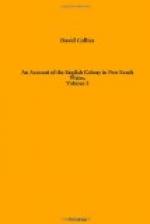In the ovi-viviparous dog-fish, the internal organs of the female have a very similar structure. There is therefore every reason to believe, that this animal also is ovi-viviparous in its mode of generation.
* * *
It appears, by accounts which have been received from New South Wales, that the voyage of the small brig Lady Nelson, commanded by Lieutenant Grant, was (notwithstanding her size, being only 60 tons burden, and the distance she had to sail) effected without her meeting with any material accident; she arriving in December 1801. Her commander was so perfectly acquainted with her good qualities, that he ventured to make the land of New Holland, in latitude 38 degrees 00 minutes south, coasting for some distance toward the eastward, and sailing through Bass Strait, in his way up to Port Jackson.
It does not appear, that this passage of the Lady Nelson through the Strait added any thing new to the discoveries which had been previously made by Captain Flinders and Mr. Bass, in the little sloop Norfolk, except that of having made the land about four degrees further to the westward than had been seen by those gentlemen.
By means of a few such vessels as the Lady Nelson, well commanded, and furnished with instruments requisite for carrying on a maritime survey, the necessary knowledge of the coast of that extensive country would soon be obtained. Governor Hunter, who is well known to be thoroughly qualified in this essential part of maritime education, has been frequently heard to say, that with a few small vessels, perhaps three or four, if he could have obtained them, or if his instructions would have permitted his building them, he would in the course of a short period have gained some acquaintance with all that part of the coast which Captain Cook had not an opportunity of examining minutely.
Large vessels, in his opinion, were not wanted for such a survey, nor were they fit for the purpose. A deposit of the stores necessary for this service could be made at the principal settlement, where such vessels, whenever requisite, might refit or repair. Large ships are proper to be employed only when they are to survey an unknown coast, where supplies are not to be had; this rendering it expedient that they should be sufficiently capacious to carry a considerable stock of provisions and stores for all their purposes. The small vessel, if caught upon a lee shore, and unable to work off, has a chance of finding security for anchorage where a large ship cannot; and if no such shelter offer, she has in her favour a greater probability of saving her crew by running on shore; her light draught of water admitting her to approach the land much nearer than could the large vessel.




